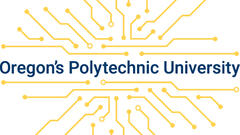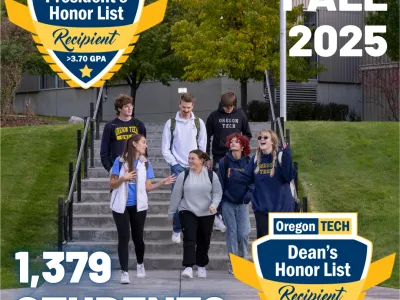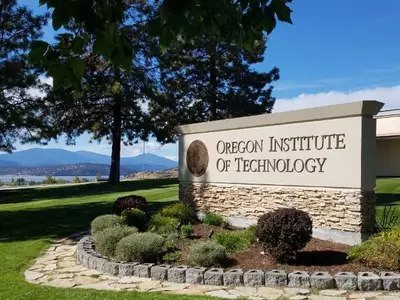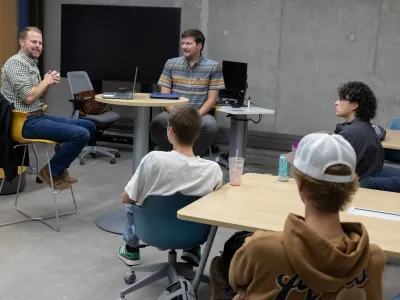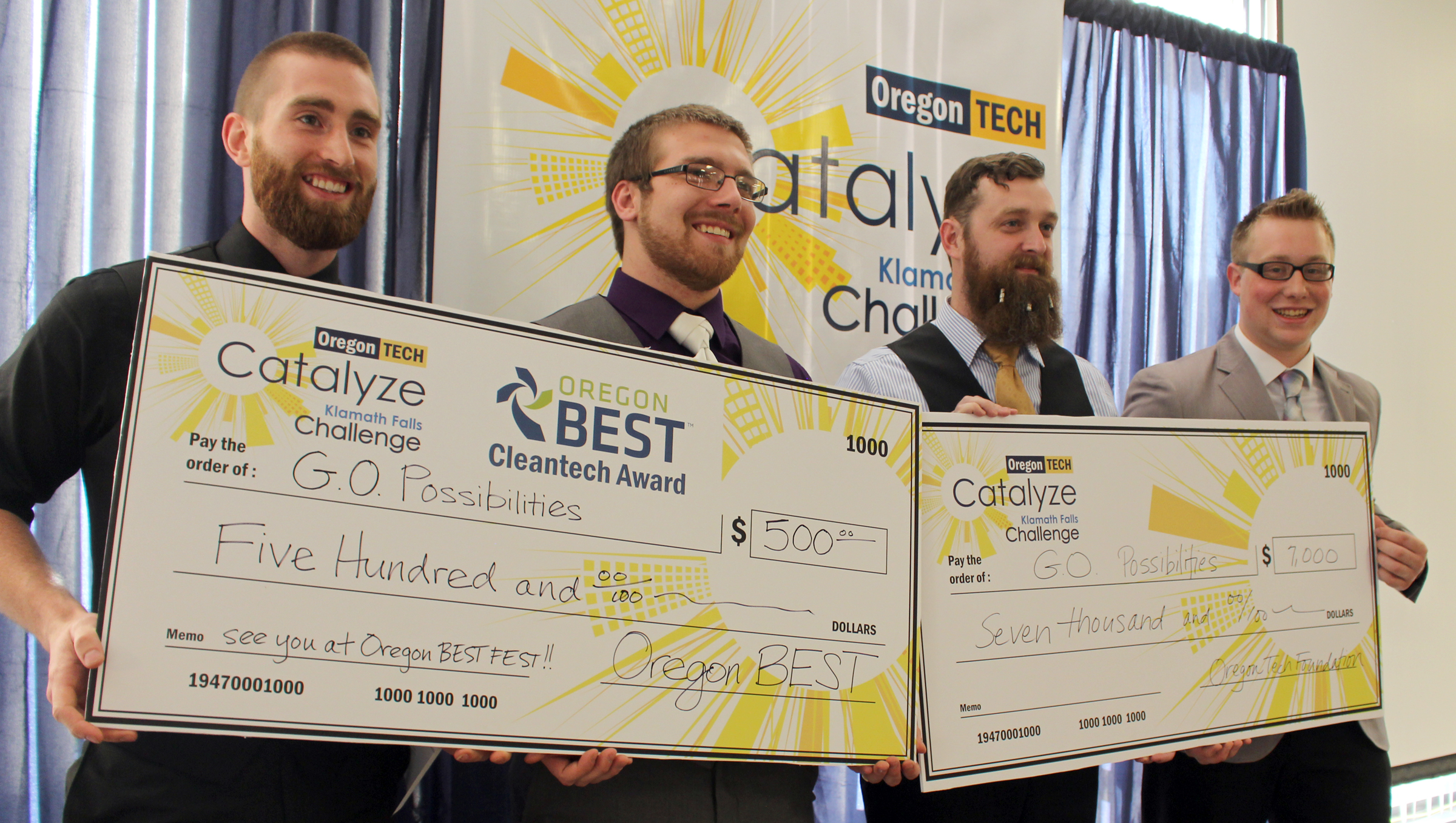
Innovative, highly technical and eager student entrepreneurs at the Oregon Institute of Technology (Oregon Tech) came together on Tuesday to compete for seed money to turn their product ideas and prototypes into real businesses. The winning team, called GO Possibilities, won based on their production of graphene oxide and development of 3-D printers that convert it into printable sheets used for energy storage in numerous applications.
This is the second annual Catalyze Challenge, which began with the concept of keeping Oregon Tech graduates in Klamath Falls to start entrepreneurial efforts after graduation, and help spur economic growth and stability in the region. Current undergraduate and graduate students as well as recent alumni who graduated in the last two years and live in Klamath Falls are eligible to enter the competition. Up from $9,000 in 2015, this year the competition had a total prize pool of $17,000, including donated space at the Gaucho Collective. With the theme of ‘Innovation Close to Home,’ three strong teams competed in the final round of judging on Tuesday, May 17. Seven volunteer judges, all from Oregon Tech’s business, community and university connections, watched the presentations, asked many probing questions, and decided on the top winner. The distinguished judges determined which two runners up would receive $5,000 and $2,000, respectively for second and third places, and which winning plan and presentation would receive $7,000 to invest in start-up costs and ignite project development.
The three winning teams were:
- GO Possibilities (pronounced Jee-Oh), 1st Place Team: $7,000 prize for their product concepts, which included producing graphene oxide -- a highly conductive fluid that is made of carbon, is stronger than steel but lighter than paper, is flexible and transparent -- at lower cost and using less toxic chemicals than currently available products; and producing 3-D printers that can print out sheets of the graphene that can be used for energy conduction and storage in numerous products, such as cell phones and electronics. The end-user will be able to design and produce structures made of graphene at a fraction of the current cost. GO Possibilities can also print custom graphene designs for customers. Team members include Matthew Stansbury, Eric Tipler, Ben Fawver, and Tate Orlik Hill, who are Electrical Engineering and Renewable Energy Engineering students.
- Shade 10 Industries, 2nd Place Team: $5,000 prize for producing affordable Ultra 4 off-road vehicle kits, which include all of the component parts and require the end-user to weld the kit together. In total, Shade 10 is developing more than 100 parts that can be sold separately or within the kit; and they do custom fabrication work for customers. They will be selling their products online as well as in a physical location in Klamath Falls, where lower overhead will enable them to beat competitors’ pricing. Team members include Cole Branham and Boden Gahringer, Civil Engineering and Manufacturing Engineering students.
- Wit-CLAP, 3rd Place Team: $2,000 prize for a uniquely designed Gorlov-type vertical wind turbine that is less expensive, smaller, and can be mounted almost anywhere, such as on roofs and telephone poles, to serve residential and public uses. It would be especially effective in areas such as Klamath Falls that are windy, and it is sustainable through use of affordable, clean energy. Team members include Cody Carmichael, Grant Gholston, Jessica Dela-Cruz and Tyler Lewis, all Mechanical Engineering students.
Throughout the two-and-a-half-hour event, finalists presented and defended their business plans to the panel of judges which included: John Lamy, Southern Oregon regional representative for the Oregon Manufacturing Extension Partnership; Johanna Scholer, an executive with JELD-WEN; Kelley Minty Morris, Klamath County Commissioner and Oregon Tech Trustee; Rich Wykoff, an investor with the Oregon Angel Fund and retired Intel executive; Bill Castle, President of Lewis and Clark Bank; and Senator Doug Whitsett, who came up with the Catalyze concept in 2014 and provided significant prize money in both years. Also in attendance was Johanna Brickman, Director of Collaborative Innovation at Oregon BEST, who presented an additional prize of $500 to GO Possibilities for a clean tech project. Chip Massie, Executive Director of the Klamath Falls Chamber of Commerce, was the Master of Ceremonies and effectively led the teams and judges through the fast-paced, timed presentations.
Once the judges had reviewed teams’ 10-page business plans and listened to their presentations, John Lamy, Senator Whitsett and Commissioner Minty Morris announced the winners, and presented teams with their prizes. All of the judges provided constructive feedback on improving their pitches, organizational set-up, written business plans, and the importance of finding capital and investors.
New this year were two showcase entrepreneurial presentations that were not part of the competition because the teams did not qualify, but which were compelling and involved alumni, students and faculty. A team of two Oregon Tech graduates, Nicole Morgan (Class of 2010) and Sereena Thompson (Class of 2009) pitched their Klamath Falls company, Nature’s Paint, which produces a form of camouflage face paint for hunters that is easier to take off, safe for the skin and all natural. Nicole and Serena are frequent hunting partners and came up the idea after many hunting adventures when their skin itched and they wore residual face paint for a few days after because of the difficulty of removing it. Judges gave them a variety of advice, including a consideration of expanding their product line.
An Oregon Tech Renewable Energy Engineering (REE) student, David Cantrell, and a faculty member in REE, Feng Shi, presented their innovation, SolenSphere. This is a roof-mounted solar concentrator system that is shaped like a large reflective glass-covered disk, and which produces both electricity and heat. The product is still in development and testing stage and David summarized some of the issues still challenging them.
There were also several faculty members involved in the student-centered competition, helping students as mentors and advisors in the development of the projects and business plans. These included Prof. Don Lee in Mechanical and Manufacturing Engineering Technology who supervised the Wit-CLAP Team and helped them create the project concept, implement, and present it. Other faculty Team mentors included Mark Ahalt, Professor of Management; Dan Peterson, Professor of Communication; Sharon Beaudry, Professor of Management; Jeff Dickson, Professor of Health Informatics.
The 2015-16 Catalyze Klamath Falls Challenge was sponsored by the Deans of Oregon Tech’s College of Engineering, Technology, and Management (ETM), the College of Health, Arts, and Sciences (HAS), and the Office of Strategic Partnerships, under the leadership of Lita Colligan, Oregon Tech’s Associate Vice President in this area, and the key developer and organizer of the event. The event is made possible through generous sponsorship and donations from Senator Doug Whitsett and Representative Gail Whitsett; Klamath County; City of Klamath Falls; Oregon BEST; Herald and News; Gaucho Collective; Klamath Idea; Klamath County Economic Development Association; Avista; Wendt Family Foundation; and Black Canyon Woodworks in Bend, Oregon.
For more information regarding the Catalyze Klamath Falls Challenge, visit www.oit.edu/catalyze.

